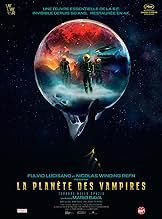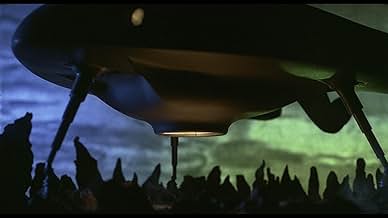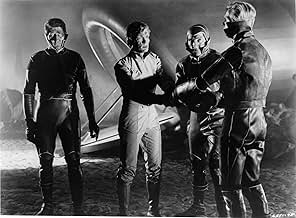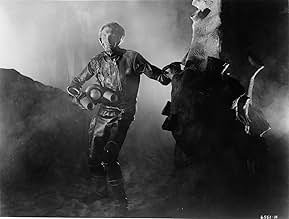NOTE IMDb
6,2/10
7,8 k
MA NOTE
Après avoir atterri sur une planète mystérieuse, une équipe d'astronautes commence à se retourner les uns contre les autres, à cause de l'influence incertaine de la planète et de ses étrange... Tout lireAprès avoir atterri sur une planète mystérieuse, une équipe d'astronautes commence à se retourner les uns contre les autres, à cause de l'influence incertaine de la planète et de ses étranges habitants.Après avoir atterri sur une planète mystérieuse, une équipe d'astronautes commence à se retourner les uns contre les autres, à cause de l'influence incertaine de la planète et de ses étranges habitants.
- Réalisation
- Scénario
- Casting principal
- Récompenses
- 1 nomination au total
Ángel Aranda
- Wess Wescant
- (as Angel Aranda)
Federico Boido
- Keir
- (as Rico Boido)
Vito Fasano
- Dead Galliott Crew Member
- (non crédité)
Giuseppe Mattei
- Brent
- (non crédité)
Avis à la une
In typical Bava fashion this movie has great visuals, atmosphere, and a great overall 'feel' of uneasiness. The story is very well done and ahead of it's time, and parts of it were later used (and referenced in) Alien.
Two ships land on a mysterious planet after receiving a distress call, only it turns out it wasn't in distress at all... it was a lure so they can spring a trap. The bodyless aliens turn the crew against each other so they can take over their bodies, leaving the living to wonder who's on their side and who's been taken over by the unseen enemy.
This is a great early sci-fi gem that has a great mix of horror, a mix between Star Trek and Invasion of the Body Snatchers is how this could be described. Worth a watch if you can find it.
Two ships land on a mysterious planet after receiving a distress call, only it turns out it wasn't in distress at all... it was a lure so they can spring a trap. The bodyless aliens turn the crew against each other so they can take over their bodies, leaving the living to wonder who's on their side and who's been taken over by the unseen enemy.
This is a great early sci-fi gem that has a great mix of horror, a mix between Star Trek and Invasion of the Body Snatchers is how this could be described. Worth a watch if you can find it.
Mario Bava's Planet of the Vampires is one of the films credited as being a major influence on Ridley Scott's Alien (1979), and it's easy to see why: there are numerous scenes and elements that are very similar to those in Scott's movie (albeit with a distinct '60s Euro sci-fi flavour). Bava's movie isn't on a par with Alien in terms of overall quality-the movie suffers a little from its low budget and it treads water for a long while-but its sense of style and originality still makes it a lot of fun for those who enjoy retro sci-fi/horror.
The film starts as the crew of the spaceship Argos (a horseshoe shaped craft, much like the alien spaceship in Alien) approach the planet Aura having receiving a strange transmission (as in Alien). They land on the foggy surface of the planet (as in Alien) and are immediately gripped by a compulsion to attack each other. After this spate of craziness passes, the crew walk to their sister ship, the Galliot, which also landed on the planet, and find the crew dead. Further investigation of the surrounding area reveals the wreck of an alien ship (as in Alien) where they discover the giant skeletons of its extraterrestrial crew (as in Alien). Eventually, it transpires that the space signal intercepted by the Argos was sent by a dying race that seeks to inhabit any visitors unfortunate to land on their planet (parasitic creatures - Alien anyone?).
For all of their similarities, Bava's film couldn't be much more different to Alien in terms of style: whereas Scott's film aimed for a gritty sense of realism, Bava's is much more rooted in pulp sci-fi comics, with the strangely spacious spaceship Argus, its crew's snazzy uniforms (the collars and hoods are hilarious), lots of high tech equipment with flashing diodes, a bright colour palette, and strong use of light and shadow. The film also predates George Romero's Night of the Living Dead with the reanimated crew of the Galliot more akin to modern day zombies than vampires.
After quite a bit of filler, the surviving members of the Argus finally escape Aura, the film ending with a twist worthy of an episode of Rod Serling's The Twilight Zone.
6.5 out of 10, rounded up to 7 for the tasty female crew members of the Argus, sexy redhead Sanya (Norma Bengell) and blonde hottie Tiona (Evi Marandi).
The film starts as the crew of the spaceship Argos (a horseshoe shaped craft, much like the alien spaceship in Alien) approach the planet Aura having receiving a strange transmission (as in Alien). They land on the foggy surface of the planet (as in Alien) and are immediately gripped by a compulsion to attack each other. After this spate of craziness passes, the crew walk to their sister ship, the Galliot, which also landed on the planet, and find the crew dead. Further investigation of the surrounding area reveals the wreck of an alien ship (as in Alien) where they discover the giant skeletons of its extraterrestrial crew (as in Alien). Eventually, it transpires that the space signal intercepted by the Argos was sent by a dying race that seeks to inhabit any visitors unfortunate to land on their planet (parasitic creatures - Alien anyone?).
For all of their similarities, Bava's film couldn't be much more different to Alien in terms of style: whereas Scott's film aimed for a gritty sense of realism, Bava's is much more rooted in pulp sci-fi comics, with the strangely spacious spaceship Argus, its crew's snazzy uniforms (the collars and hoods are hilarious), lots of high tech equipment with flashing diodes, a bright colour palette, and strong use of light and shadow. The film also predates George Romero's Night of the Living Dead with the reanimated crew of the Galliot more akin to modern day zombies than vampires.
After quite a bit of filler, the surviving members of the Argus finally escape Aura, the film ending with a twist worthy of an episode of Rod Serling's The Twilight Zone.
6.5 out of 10, rounded up to 7 for the tasty female crew members of the Argus, sexy redhead Sanya (Norma Bengell) and blonde hottie Tiona (Evi Marandi).
Astronauts land on a mysterious planet and encounter many strange and dangerous things--like bodies that don't stay dead.
This Italian movie has horrendous dubbing (except for American Barry Sullivan), silly "special" effects and truly laughable, comic book level dialogue. But it's still worth seeing.
Director Mario Bava was a master at creating spooky atmospheres out of no budget. This was a VERY low budget film (it shows), but he covers it up with beautiful, inventive lighting, tons of dry ice and a really scary score. Also the astronauts wear tight leather outfits which are interesting and some of the Italian guys give good performances--Sullivan is horrible and the women are beyond belief. Also the film contains a few nice jolts and some very scary coming back from the dead sequences.
So, ignore the lousy dialogue and preposterous plot and concentrate on the visuals and sounds. Perfect late night viewing.
This Italian movie has horrendous dubbing (except for American Barry Sullivan), silly "special" effects and truly laughable, comic book level dialogue. But it's still worth seeing.
Director Mario Bava was a master at creating spooky atmospheres out of no budget. This was a VERY low budget film (it shows), but he covers it up with beautiful, inventive lighting, tons of dry ice and a really scary score. Also the astronauts wear tight leather outfits which are interesting and some of the Italian guys give good performances--Sullivan is horrible and the women are beyond belief. Also the film contains a few nice jolts and some very scary coming back from the dead sequences.
So, ignore the lousy dialogue and preposterous plot and concentrate on the visuals and sounds. Perfect late night viewing.
Mario Bava does it again. The crystal colours, eerie atmosphere and evocative visuals are downright dazzling and haunting in this low-budget Italian Sci-fi outing. Never have I been disappointed in these technical aspects while experiencing the master at work. Many have mentioned it and the influences / similarities to Ridley Scott's 'Alien (1979)' ultimately sticks out. Even with that in mind it does share some ideas with the body snatcher theme, but it was a cleverly done concept done in a slow grinding, but extremely engaging style. The pacing is slow, but the flashy imagery and smoothly placed camera-work was hypnotic that it helped time flow by. My only real gripe was that the script was on the stilted side, but other than that it was one of those subtlety breezy mood pieces. More often the deaths happen off-screen and it's mostly free of action, to really only hit in the dying stages in some rapid set-pieces, but it's the dreary ending that's a strike of genius. Bava's crisp direction lets the otherworldly Gothic vibe take hold and while the sterile set designs look cheap it manages to be effective in its unusually stylish looks (add in seeping fog) and this invokes brooding unease and alienation. The surrounding sound effects and music score are creepily orchestrated. As for the special effects/make-up FX for such a low-cost production, they were well executed and ideally used. The acting can be rather rough in a staged sense with a dependable Barry Sullivan heading the way. Some of the characters were hard to tell apart though. A marvellously old-fashion, but influentially chilling space expedition.
In the film PLANET OF THE VAMPIRES, there is an undeniable creeping dread, a very real sense of terror, in every scene. Despite the obvious lack of money, Bava wrung some eerie, disturbing imagery out of his sf schlock piece. Considering this is an Italian production of the mid-60s, director Bava infuses some real originality into his story, taking a 1950s crew of square-jawed astronauts and forcing them to confront the future of horror: a horde of gore-streaked zombies, an omnipresent supernatural force invading the crew's minds, and a nihilistic ending.
What is great about POTV stems from Bava, his dynamic camera, and his framing. The marooned spacecraft atop a craggy hillside, approached by rescuing astronauts, looks like a haunted house against the black-clouded sky of the planet. When the living dead begin stalking the pitted, fiery surface of the planet, intent on killing the astronauts, Bava effectively uses the new horror icons of fear: not of fear, but of zombiefication, of characters who could be us, once just human, but now horribly returned as mutilated living corpses set to kill friends and family.
PLANET OF THE VAMPIRES is exciting, arresting in places, and nuanced in small ways even by the actors involved, all of them physically fit with numerous fight scenes. Sullivan and Bengall aren't creating their
characters, but they react realistically as human beings in an increasingly hopeless situation. The final scenes, of the
astronauts attempt to escape the planet, set upon by the living dead, have a psychological edge to go along with the action, as these noble travelers overcome their fear of the planet, of the zombies, and the horrible prospect of becoming zombies themselves, in order to end the hungering menace all around them. These scenes predate the best of George Romero's DEAD films or any John Carpenter flick, where a group of survivors are whittled down to just a few, and then to one, by a wave of seemingly unstoppable supernatural force.
It should be noted that "vampires" refer to parasites, not classic monsters, and truly this is more of a "zombie" film than a "vampire" movie. The film Bava made is gory and violent for 1965 when it was released, and as interesting as it was then, it's just as interesting now to see how POTV influenced later horror-film greats, not only in theory but in execution. And it's still better than 95 percent of the recent Hollywood sf-horror films of the past decade, bar none.
What is great about POTV stems from Bava, his dynamic camera, and his framing. The marooned spacecraft atop a craggy hillside, approached by rescuing astronauts, looks like a haunted house against the black-clouded sky of the planet. When the living dead begin stalking the pitted, fiery surface of the planet, intent on killing the astronauts, Bava effectively uses the new horror icons of fear: not of fear, but of zombiefication, of characters who could be us, once just human, but now horribly returned as mutilated living corpses set to kill friends and family.
PLANET OF THE VAMPIRES is exciting, arresting in places, and nuanced in small ways even by the actors involved, all of them physically fit with numerous fight scenes. Sullivan and Bengall aren't creating their
characters, but they react realistically as human beings in an increasingly hopeless situation. The final scenes, of the
astronauts attempt to escape the planet, set upon by the living dead, have a psychological edge to go along with the action, as these noble travelers overcome their fear of the planet, of the zombies, and the horrible prospect of becoming zombies themselves, in order to end the hungering menace all around them. These scenes predate the best of George Romero's DEAD films or any John Carpenter flick, where a group of survivors are whittled down to just a few, and then to one, by a wave of seemingly unstoppable supernatural force.
It should be noted that "vampires" refer to parasites, not classic monsters, and truly this is more of a "zombie" film than a "vampire" movie. The film Bava made is gory and violent for 1965 when it was released, and as interesting as it was then, it's just as interesting now to see how POTV influenced later horror-film greats, not only in theory but in execution. And it's still better than 95 percent of the recent Hollywood sf-horror films of the past decade, bar none.
Le saviez-vous
- AnecdotesThis film marks the first collaboration between Mario Bava and his son/assistant director Lamberto Bava. Lamberto would later become a director himself.
- GaffesWhen Toby and Mark duke it out, Toby bumps into and moves the flight seat revealing it to be unattached to the deck.
- Citations
Capt. Mark Markary: I'll tell you this, if there 'are' any intelligent creatures on this planet... they're our enemies.
- Versions alternativesThe original Italian version runs 88 minutes long. The US version runs 86 minutes long.
- ConnexionsFeatured in Aweful Movies with Deadly Earnest: The Demon Planet (1969)
Meilleurs choix
Connectez-vous pour évaluer et suivre la liste de favoris afin de recevoir des recommandations personnalisées
- How long is Planet of the Vampires?Alimenté par Alexa
- Is 'Planet of the Vampires' based on a book?
- What language are they speaking?
- How does the movie end?
Détails
- Date de sortie
- Pays d’origine
- Langues
- Aussi connu sous le nom de
- El planeta de los vampiros
- Lieux de tournage
- Sociétés de production
- Voir plus de crédits d'entreprise sur IMDbPro
Box-office
- Budget
- 200 000 $US (estimé)
- Durée1 heure 28 minutes
- Mixage
- Rapport de forme
- 1.66 : 1
Contribuer à cette page
Suggérer une modification ou ajouter du contenu manquant

Lacune principale
What is the Brazilian Portuguese language plot outline for La Planète des vampires (1965)?
Répondre



























